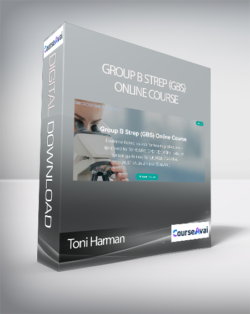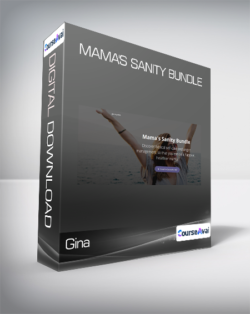Evidence-based course for health professionals approved for 10 HOURS CPD/CE/CERPs. Includes clinical guidelines for UK, USA, CANADA, AUSTRALIA & NEW ZEALAND Purchase Toni Harman – Group B Strep (GBS) Online Course courses at here with PRICE $80 $28Toni Harman – Group B Strep (GBS) Online CourseGroup B Strep (GBS) Online Course Evidence-based course for health professionals approved for 10 HOURS CPD/CE/CERPs. Includes clinical guidelines for UK, USA, CANADA, AUSTRALIA & NEW ZEALAND “I found this course very helpful. It was very well presented, and I plan to update my informed choice about GBS and it’s risks with some new information I learned.” – Karen, Home Birth Midwife, Wisconsin, USA“I wanted to comment on the quality of this course. I found it fantastic” – Lauren, Medical Student, Canada“A thorough, convenient course that will help me educate my birth doula clients so they can make the best decisions for their own health and that of their babies.”– Susan, Birth Doula, San Francisco, USA“Another amazing course from Toni and the Microbirth Team. I come away from each course motivated and inspired and mostly grateful for such interesting, relevant, and up to date information that I can share with my clients in an easy to understand way. Look forward to the next one!” – Michelle, Birth Doula, JapanGROUP B STREP (GBS) ONLINE COURSEFor Health Professionals Helping YOU feel more confident about group B Strep.Helping YOU support parents with full informed choice. Evidence-based with up-to-date references Easy-to-understand & easy-to-digest Go-at-your-own pace so you can take days, months or up to 3 years to complete course (and claim your CE credits!) Learn from 5 world-leading professors and experts Approved for 10 CPD HOURS / CE credits Downloadable handouts & Certificate of Completion Remember, this information can save lives.Group B Strep is the leading cause of serious infection (meningitis & sepsis) in newborn babies. Aimee was born 23rd July 2011 and very quickly developed early-onset GBS meningitis. Aimee was treated with IV antibiotics and survived. Aimee has severe quadiplegic spastic dystonia cerebral palsy affecting all four limbs, and pseudobulbar palsy affecting her eating and ability to talk. (Photo credit: Aimee’s mother, Charlotte) Approved Continuing Education for midwives, doulas, childbirth educators and lactation consultants Group B Strep (GBS) Online Course has been approved for:10 CPD HOURS approved by the Australian College of Midwives (ACM) 10 HOURS approved by the Midwifery Council (New Zealand) Alto Films Ltd Approval Number: 2018CME038E11.0 LAMAZE CONTACT HOURS approved by Lamaze International #LIN 18-1411.0 CONTACT HOURS accepted by The International Childbirth Education Association (ICEA) #LIN 18-1410.5 CERPS (8.5 R-CERPs & 2 L-CERPs) approved by the International Board of Lactation Consultants Examiners (IBLCE) CERPs Registry Number 320039K This course can be used as 10 HOURS CPD for revalidation by the Nursing and Midwifery Council (NMC)10 HOURS or 1.0 Midwifery CEU credits by the Midwifery Education & Accreditation Council ( Program No MEAC ID #M2021-09-1010DE). These 10 HOURS / 1.0 Midwifery CEUs are applicable for Certified Professional Midwives recertifying through the North American Registry of Midwives (NARM). If you are a midwife, lactation consultant, doula, childbirth educator or other health professional, the following CPD / CE credits are accepted by many midwifery, nursing, doula, childbirth education orgnanizations including: IBLCE, ACM, ICEA, DONA International, CAPPA and Lamaze International.Group B Strep (GBS) Online Course Accredited Continuing Education from 5 leading group B Strep experts VICTOR NIZET: Professor & Vice Chair for Basic Research, Department of Pediatrics & Chief, Division of Host-Microbe Systems & Therapeutics. And Professor, Skaggs School of Pharmacy & Pharmaceutical Sciences, University of California San DiegoMEGHAN AZAD: Assistant Professor of Pediatrics and Child Health at the University of Manitoba, Canada. Dr. Azad serves on the Executive Council for the International Society for Research in Human Milk and Lactation, and the Breastfeeding Committee of Canada.ANITA KOZYRSKYJ: Professor in the Department of Pediatrics, University of Alberta, Canada. Dr Kozryskyj is the PI of SyMBIOTA (Synergy in Microbiota) research program, one of the seven CIHR-funded Canadian Microbiome Initiative teamsPHILIP STEER: Emeritus Professor of Obstetrics, Imperial College London. Dr Steer has authored 135 research papers, and many reviews, editorials and book chapters/books. Former Editor-in-Chief of BJOG – an International Journal of Obstetrics and Gynaecology, he is the current Chair of the GBS Support medical advisory panel.JANE PLUMB MBE: Chief Executive, Group B Strep Support. A former member of the Department of Health priority setting workshops for GBS research and current member of the International Symposium on Streptococcus Agalactiae Disease scientific committee. Co-vice chair of the Royal College of Obstetricians & Gynaecologists’ Women’s Network.Evidence-based visual presentations combined with HD short videos For example, from Session 2 on group B Strep in newborns: Course Content covers:Group B Strep and the human microbiome – including the microbial properties and the special virulence factors of GBS (learn what they are in the course!)Group B Strep and vaginal birth, C-section and preterm birth Explanation of ‘Universal Screening’ and ‘Risk-based’ approaches to prevent GBS infectionsLatest research on maternal IV antibiotics for GBS and the potential impact on the infant microbiomeLatest research on breastfeeding and group B StrepLatest developments about a potential maternal GBS vaccineClinical guidelines to prevent GBS infections for USA, Canada, Australia, New Zealand and UKGROUP B STREP (GBS) ONLINE COURSE USD $80 / AUD $118 / CAD $107 / NZD $125 / GBP £66 / EURO 73 / ZAR 1223 + local taxes This is a one-time purchase. There are no recurring fees. Purchase of this course gives you access to the course content for 3 years.10 HOURS CPD / CE / CERPs can be claimed when needed for re-certification. The usual price for this course is USD $247 – but we want to make this critical information affordable by all, so we have discounted the price to USD $80 price for a limited time only. Group BookingsFor groups, the person who makes the purchase will be emailed access codes to distribute to all members of the group. Each group member will use the access code to create their own account. CPD/CEU credits are claimed by each individual upon completion of the course.For larger groups of more than 10 people, including schools, colleges, universities or organisations, please CONTACT US for a bespoke quote.Groups of 10: USD $400 + local taxesCourse CurriculumGroup B Strep (GBS) Online CourseSTART HERE: GROUP B STREP (GBS) ONLINE COURSEHello and welcome!Connect with us!Course InstructionsHow does the course work?Note on copyrightNotes on gender and spellingLegal Disclaimer 1Legal Disclaimer 2List of Course ContentsFeatured SpeakersDeclarations of InterestSession 1: Introduction to Group B Strep (GBS)1. Session One: Learning Objectives2. VIDEO: Why do you care about GBS? (2:56)3. What is group B Strep?4. VIDEO: What is group B Strep? (1:06)5. Microbial properties of group B Strep6. VIDEO: Microbial properties of group B Strep (5:22)7. GBS and the human microbiome8. VIDEO: Group B Strep and the human microbiome (2:19)9. Carrying GBS in the human microbiome10. VIDEO: Difference between carrying group B Strep and having a group B Strep infection? (1:24)11. How is GBS carriage detected?12. VIDEO: Who is most vulnerable to GBS infections? (1:46)13. GBS infection in adults14. Session One: Science References15. Session One: Graded Test16. Session One: Downloadable Handouts17. Session One: Discussion ForumSession 2: Group B Strep and Newborns1. Session Two: Learning Objectives2. VIDEO: GBS infection in newborns: A serious global problem (1:03)3. Global statistics for carrying GBS in pregnancy4. VIDEO: How can infants acquire group B Strep during labour and vaginal childbirth? (2:40)5. How can infants acquire GBS during labour and vaginal birth?6. VIDEO: How can infants acquire group B Strep after birth? (1:43)7. How can infants acquire GBS after birth?8. VIDEO: Risk of a newborn developing a GBS infection (3:22)9. Risk of a newborn developing GBS infection10. VIDEO: GBS infection and preterm birth (1:37)11. GBS infection and preterm birth12. VIDEO: GBS infection with C-section (0:49)13. GBS and C-section14. Session Two: Science References15. Session Two: Graded Test16. Session Two: Downloadable handouts17. Session Two: Discussion ForumSession 3: Signs Of Early And Late Onset GBS infection1. Session Three: Learning Objectives2. VIDEO: Difference between early-onset and late-onset GBS infections (1:47)3. GBS is a serious risk to infant health4. VIDEO: GBS is a cause of stillbirth (2:19)5. GBS is a cause of stillbirth6. VIDEO: Signs of early-onset GBS infection (1:49)7. Signs of early-onset GBS infection8. VIDEO: Signs of late-onset group B Strep infection (1:28)9. Signs of late-onset GBS infection10. VIDEO: Diagnosing group B Strep infection (1:06)11. Rate of GBS infections across the world12. VIDEO Treating group B Strep infection with antibiotics (1:45)13. Treating GBS infections with antibiotics14. VIDEO: Morbidity and mortality rates for GBS infection (2:27)15. Key morbidity and mortality statistics from around the world16. Session Three: Science references17. Session Three: Graded Test18. Session Three: Downloadable Handouts19. Session Three: Discussion ForumSession 4: Strategies For Preventing Early-Onset GBS Infection1. Session Four: Learning Objectives2. VIDEO: With no symptoms, how can you tell if you are a carrier for GBS? (1:38)3. Types of test for GBS during pregnancy4. VIDEO: Types of test for GBS carriage (2:14)5. ‘Risk-based’ and ‘Universal testing’ strategies for GBS6. VIDEO: What is the ‘Risk-based’ approach for GBS during pregnancy? (2:43)7. What is a ‘Risk-based’ approach to GBS during pregnancy?8. VIDEO: What is ‘Universal screening’ for GBS during pregnancy? (2:14)9. What is ‘Universal screening’?10. VIDEO: Procedure for testing mother for GBS at 35-37 weeks’ gestation (1:54)11. If a woman tests positive for carrying GBS12. VIDEO: Effectiveness of ‘Universal Screening’ compared to the ‘Risk-based approach’ for GBS (1:19)13. Which approach is more effective?14. Session Four: Science References15. Session Four: Graded Test16. Session Four: Downloadable Handouts17. Session Four: Discussion ForumSession 5: Preventing GBS Infections With IV Antibiotics1. Session Five: Learning Objectives2. VIDEO: Preventing GBS infections with antibiotics (1:29)3. How effective are Intrapartum Antimicrobial Prophylaxis (IAP) at preventing early-onset GBS infections4. VIDEO: When are Intrapartum Antimicrobial Prophylaxis (IAP) administered? (0:47)5. When are Intrapartum Antimicrobial Prophylaxis IAP administered6. VIDEO: How are Intrapartum Antimicrobial Prophylaxis (IAP) administered? (1:19)7. Which antibiotic at what dosage?8. VIDEO: What if a mother is allergic to penicillin? (0:43)9. Severe reaction to penicillin (anaphylaxis)10. VIDEO: Risk of serious anaphylactic allergic reaction to antibiotics? (1:03)11. Observe baby rather than IAP12. VIDEO: Observe baby rather than IAP (1:07)13. Session Five: Science References14. Session Five: Graded Test15. Session Five Downloadable Handouts16. Session Five: Discussion ForumPART TWO: GUIDELINES FOR UK, USA, CANADA, AUSTRALIA AND NEW ZEALAND1. Session Six Learning Objectives2. Session 6: Updates and Disclaimer3. Session Six: Reminder of clinical termsSession 6: Guidelines for UK6a UK RCOG Green–top Guideline No. 36 2017 – Summary of some points from guidelines6b. UK RCOG Green–top Guideline No. 36 2017 – List of clinical risk-factors6c. UK RCOG Green–top Guideline No. 36 2017 – Explanation of antibiotic dosage6d. UK RCOG Green–top Guideline No. 36 2017 – Summary of risk-based approach if mother is in labour6e. UK RCOG Green–top Guideline No. 36 2017 – Induction membrane sweeping or Caesarean6f. UK RCOG Green–top Guideline No. 36 2017 -Summary after baby is bornSession 6: Downloads for Guidelines for UKSession 6: Guidelines for USA6a. USA ACOG 2019 Summary of key points from guidelines6b USA ACOG 2019 If the prenatal GBS culture is positive6c USA ACOG 2019 If the prenatal GBS culture result is unknown6d USA ACOG 2019 If allergic to penicillin6e USA ACOG 2019 Obstetric interventions should not be delayed6f USA ACOG 2019 If preterm labour or rupture of membranes before 37 weeks6g USA ACOG 2019 Summary of when IAP indicated6h USA ACOG Committee Opinion 797 – Feb 20206i USA ACM Guidelines March 20206j: USA AAP Clinical Report July 2019Session 6: Downloads for Guidelines for USASession 6: Guidelines for CANADA6a Canada SOGC 2018 Summary and statement6b Canada SOGC 2018 Recommendation No. 1 Universal Screening6c Canada SOGC 2018 Recommendation No. 2 IAP for GBS6d Canada SOGC 2018 Recommendation No. 3 Preterm or rupture of membranes6e Canada SOGC 2018 Recommendation No. 4 Intrapartum fever and chorioamnionitis6f Canada SOGC 2018 Recommendation No. 5 Antibiotic susceptibility testing6g Canada SOGC 2018 Recommendation No. 6 Term pre-labour rupture of membranes6h Canada SOGC 2018 Recommendation No. 7 Unknown GBS status at term and ruptured membranes over 18 hours6i Canada SOGC 2018 Recommendation No. 8 Preterm pre-labour rupture of membranes6j Canada SOGC 2018 Recommended antibiotic regimens for intrapartum prophylaxisSession 6: Downloads for Guidelines for CANADASession 6: Guidelines for AUSTRALIA AND NEW ZEALAND6a Australia and New Zealand RANZCOG 2016 Summary of some points in guidelines6b Australia and New Zealand RANZCOG 2016 guidelines – Flowchart for risk-factor approach6c Australia and New Zealand RANZCOG 2016 guidelines – Flowchart for Universal Screening6d Australia and New Zealand RANZCOG 2016 guidelines – Flowchart for Specific Clinical Scenarios6e Australia and New Zealand RANZCOG 2016 guidelines – Flowchart for antibiotic dosage for IAP and Conclusion6f New Zealand Consensus 2014 Guideline – Summary of recommendations6g New Zealand Consensus 2014 Guideline – Management of newborn babiesSession 6: Downloads for Guidelines for AUSTRALIA AND NEW ZEALANDSession 6: Science references, test and handoutsSession Six Science referencesSession Six: Graded TestSession Six: Downloadable HandoutsSession Six: Discussion ForumSession 7: Two Small Studies On The Impact Of Intrapartum Antimicrobial Prophylaxis (IAP) On The Infant Microbiome1. Session Seven Learning Objectives2. VIDEO: General thoughts on the impact of Intrapartum Antibiotic Prophylaxis (IAP) on the infant microbiome (3:38)3. Two small studies comparing impact of IAP on infant gut microbiome4. VIDEO: Impact of IAP on infants at 3 months of age in the CHILD study (2016) (2:53)5. Findings of Canadian CHILD Study (2016)6. VIDEO: CHILD Study (2016): Maternal antibiotics associated with decrease of Bacteroidetes (2:08)7. Canadian CHILD study – Age 3 months, different bacterial pattern after exposure to maternal IV antibiotics8. VIDEO: Child health implications of maternal IAP – Risk of food sensitisation? (1:29)9. CHILD Study (2016) Increased risk of food sensitisation10. VIDEO: Summary of findings of CHILD Study (2016):IAP and increased risk for food sensitisation (2:13)11.Session Seven: Science references12. Session Seven: Graded Test14. Session Seven: Downloadable Handouts15. Session Seven: Discussion ForumSession 8: Evidence For Other Strategies To Prevent GBS Infections1. Session Eight Learning Objectives2. VIDEO: IAP for every pregnant woman (1:19)3. IAP for every pregnant woman4. VIDEO: Eradicating GBS carriage during pregnancy? (2:24)5. Can GBS carriage be eradicated?6. VIDEO: Can probiotics reduce GBS colonisation? (0:57)7. Do probiotics reduce GBS colonisation?8. Session Eight Science references9. Session Eight: Graded Test10. Session Eight: Downloadable Handouts11. Session Eight: Discussion ForumSession 9: GBS and Breastfeeding1. Session Nine: Learning Objectives2. VIDEO: How does breastfeeding impact GBS? (2:01)3. Can breastfeeding modify changes from maternal IV antibiotics given before birth?4. VIDEO: Can breastfeeding help ‘restore’ the compositional changes in the infant microbiome? (2:42)5. Could breast milk help prevent GBS infection in babies?6. VIDEO: Summary of impact of breastfeeding after exposure to antibiotics (0:49)7. Session Nine: Science references8. Session Nine: Graded Test9. Session Nine: Downloadable Handouts & Extra Reading10. Session Nine: Discussion ForumSession 10: Potential For A Future Vaccine To Prevent GBS Infections1. Session Ten Learning Objectives2. VIDEO: Possibility of a vaccine to prevent GBS infections? (2:47)3. Maternal vaccines for Pertussis, Neonatal Tetanus, Respiratory Synctial Virus (RSV) and Pneumonia4. VIDEO: Could a vaccine help prevent GBS infections? (1:52)5. A maternal vaccine for GBS6. VIDEO: Progress with GBS vaccine research (5:25)7. IV antibiotics would still be needed8. VIDEO: How soon could a GBS vaccine be ready? (2:02)9. GBS vaccines in development10. VIDEO: What is your take-home message? (2:03)11. Session Ten Science references12. Session Ten: Graded Test13. Session Ten: Downloadable Handouts14. Session Ten: Discussion ForumSession 11: Downloadable Handouts, Student Evaluation and Certificate of Completion1. Session Eleven: Course Downloadable Handouts2. Group B Strep (GBS) Online Course: Student Evaluation Form3. Group B Strep (GBS) Online Course: Discussion Forum4. Group B Strep (GBS) Online Course: Certificate of Completion4b. Midwifery Council (New Zealand) – Certificate of Completion, Reflection Forms, Course Schedule and Reference ListWANT MORE?Join our other coursesFinal thoughtsSales PageArchive PagePurchase Toni Harman – Group B Strep (GBS) Online Course courses at here with PRICE $80 $28
Toni Harman – Group B Strep (GBS) Online Course
₹4,648.00








